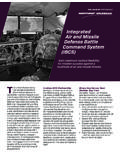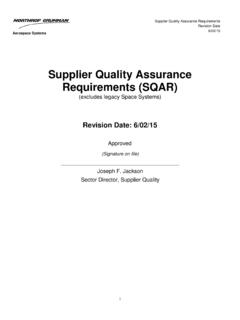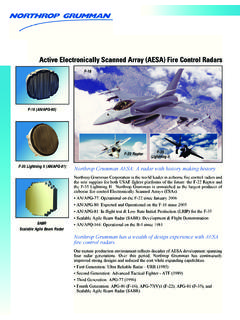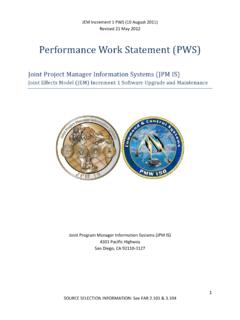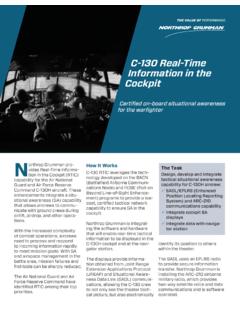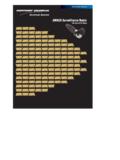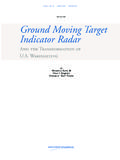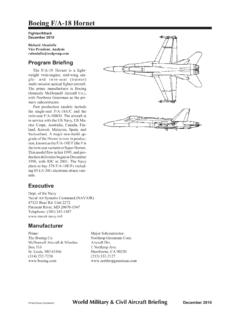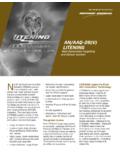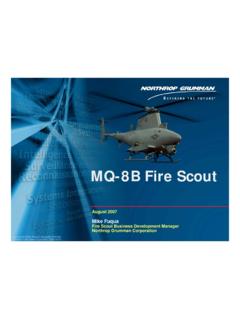Transcription of Aerospace System Improvements Enabled ... - Northrop …
1 1 Aerospace System Improvements Enabled By Modern Phased Array Radar Northrop grumman Electronic Systems Baltimore, Maryland October 2002 Robert Hendrix Chief Engineer Airborne Surveillance Systems (410) 765 3101 / (253) 773-2333 ABSTRACT Modern Command, Control, Communications, and Computers Intelligence, Surveillance and Re-connaissance (C4 ISR) Systems are providing unprecedented advances in national defence capabil-ity. The paper discusses the contribution that modern phased array radar enables in C4 ISR aero-space systems and their role in network centric operations. Phased array radar advancements for Aerospace platforms are reviewed from a historical and tech-nology viewpoint.
2 The operational considerations that are unique to modern phased array radar are discussed along with their impact in optimising System effectiveness and their contribution in devel-oping the Common Tactical Picture for integrated air and ground operations. ABOUT THE AUTHOR: Robert Hendrix (Bob) is Chief Engineer for Northrop grumman Electronic Systems Airborne Surveil-lance Systems in Baltimore Maryland. Northrop grumman is a leading supplier of modern C4 ISR systems including platforms, sensors, systems, and architectures for AWACS, JSTARS, 737 AEW&C, Global Hawk, F22 and Joint Strike Fighter. Mr. Hendrix joined what was the Westinghouse Electric Defence Electronics in 1962 as an Electrical Engineer.
3 He has worked in electrical design and systems engineering on airborne, surface, and subsurface radar systems within the company since that time. Mr. Hendrix earned his Bachelor of Science degree in Electrical Engineering from the University of Maryland in 1963, his Masters of Science in Electrical Engineering from the Uni-versity of Pittsburgh in 1968, and continued postgraduate work at the University of Maryland and George Washington University. He is currently developing modern C4 ISR systems. DFOISR Approved for Unlimited Publication # 2002-1522 2 Aerospace System Improvements Enabled By Modern Phased Array Radar 1.
4 INTRODUCTION Phased array radar advancement has led to unprecedented advances in Aerospace platforms and to national defence capability. Phased array radar for airborne platforms is reviewed from a histori-cal and technology viewpoint. Then operational capabilities Enabled by phased array radar are dis-cussed for several key platforms. Finally, the use of phased arrays to develop a Common Tactical Picture of air and ground targets is discussed. 2. PHASED ARRAY RADAR SYSTEMS The systems that are addressed here are systems in which Northrop grumman Electronic Systems (ES) have been involved. Northrop grumman ES, headquartered in Baltimore, Maryland USA, is a world leader in the design, development and manufacture of defence electronics and systems, pre-cision weapons, airspace management systems, space systems, marine systems, and automation and information systems.
5 Since World War II Northrop grumman has delivered over 50,000 air-borne radars, and is currently providing airborne radars on 21 aircraft types in 26 Nations. Northrop grumman ES has been designing and perfecting airborne radar systems for over 60 years, however the heritage of the phased array radar and particularly, Active Electronically Scanned Array (AESA) is relatively short. In fact, our first passive phased array radar was con-structed in 1974 and the first active phased array was built just 17 years ago in 1985. This break-through in technology allowed for the demonstration of the concept of steering beams generated by distributed transmit and receive modules.
6 Our 2nd generation AESA was the first to fly just three years later. This 2nd generation AESA was the first AESA to proceed to the Engineering and Manufacturing Development phase. Our 3rd gen-eration AESA met the high performance requirements in clutter, which mechanical or passive elec-tronically scanned arrays are unable to meet. With the high performance standard set, we focused on reducing cost and weight. This led to our 4th generation AESA that is half the cost and weight of the 3rd generation AESA. The 4th generation AESA design requirements were the result of merging requirements for air-borne, sea based, and land based platforms. Due to the nature of the changing defense environ-ment dictating commonality across the services and our own limited research and development funds, drives one to the practical decision of seeking common solutions.
7 This 4th generation AESA and its associated T/R modules achieve the design commonality while satisfying unique airborne, sea borne and ground based platform requirements with high performance to meet the mission needs. The first generation airborne surveillance radar array was the Airborne Warning And Control System (AWACS) Brassboard radar antenna System . This antenna employed passive phased shifters on each of 28 sticks of the antenna, which were used to electronically scan the antenna to obtain height measurement and stabilize the beam to compensate for aircraft roll and pitch. Electronically Scanned Array (ESA) Timeline: Northrop grumman ES is a world-leading producer of active aperture antennas.
8 Figure shows the evolution of our fire control radar active aperture development programs beginning with the 1st generation active aperture antenna in 1985 and covering up to our 5th generation multi-function ar-ray in 1998. The 4th generation active aperture (F-22) antenna is completing an EMD development 3 phase and moving towards production. The 5th generation active aperture antenna has completed initial development and is being leveraged into emerging development programs such as JSF. Figure Airborne Fire Control Radar Active Aperture Development Current development efforts are focused on the 5th generation antenna development.
9 Architectures are being investigated for the sixth generation active aperture as well, and key technologies are be-ing identified and developed. Key programs included in the roadmap include the development of a Ka-band tile and the Reconfigurable Array (RECAP). The Ka-band development effort has strategic significance to ES in the areas of radar as well as SATCOM. Airborne Fire Control Radar Active Aperture Development 1974 First development stages of EAR 1977 EAR Flight-tested 1985 URR First active aperture (1st Generation) 1988 First to fly (2nd Generation) 1989 ATF Concept Definition Phase for F-22 1991 Awarded F-22 Contract 1995 First to E&MD (3rd Generation) Six units in test High performance in clutter 1997 Range tested APG-77 (4th Generation)
10 1998 Launched 4th Generation AESA Airborne Surveillance Radar Active Aperture Development 4thGenerationMESA 20022nd GenerationAST/AR 19891st GenerationAWACS 19723rdGenertionAdvance Surveillance Testbed 19944thGenerationMESA 20022nd GenerationAST/AR 19891st GenerationAWACS 19723rdGenertionAdvance Surveillance Testbed 1994 Figure Airborne Surveillance Radar Phased Array Development 4 1970 First ultra low sidelobe phased array developed 1972 Phased array AWACS Brassboard radar System flight tested 1974 Full Scale Development of AWACS 1982 Development of JSTARS radar System (Norden Systems) 1989 First ultra low sidelobe active phased array developed (AST/AR) 1994 Flight test of Advanced Airborne Surveillance Testbed Radar (MCARM) 1998 Prototypes of Multirole Electronically Scanned Array Radar/IFF 2000 Award of 737 AEW&C MESA Radar Contract 2002 First Full Scale MESA Radar/IFF Antenna Product/ System Overviews: The EAR program was the development test bed for the future APQ-164 B-1B radar System .
